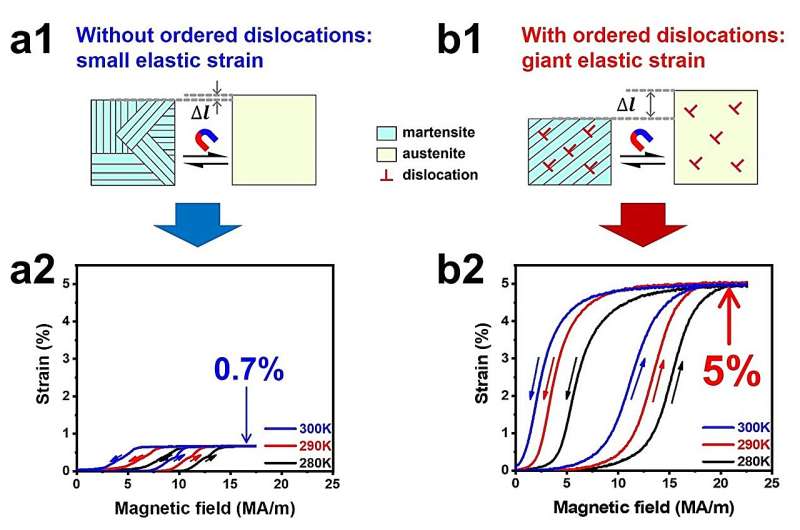This article has been reviewed according to Science X's editorial process and policies. Editors have highlighted the following attributes while ensuring the content's credibility:
fact-checked
peer-reviewed publication
trusted source
proofread
Scientists achieve giant magneto-superelasticity in metal crystal

Recently, a research group developed a giant magneto-superelasticity of 5% in a Ni34Co8Cu8Mn36Ga14 single crystal. This was achieved by introducing arrays of ordered dislocations to form preferentially oriented martensitic variants during the magnetically induced reverse martensitic transformation.
The research was published in Advanced Science.
Elasticity is the ability of materials to return to their original shape after deformation, typically with a strain of 0.2% in most metals. Shape memory and high entropy alloys can exhibit superelasticity with strains of several percent, usually triggered by external stresses. Magneto-superelasticity, induced by a magnetic field, is crucial for contactless material operation and the development of new large stroke actuators and efficient energy transducers.
The researchers, in collaboration with High Magnetic Field Laboratory at the Hefei Institutes of Physical Science of Chinese Academy of Sciences, led by Prof. Jiang Chengbao and Prof. Wang Jingmin from School of Materials Science and Engineering at Beihang University, performed a stress-constrained transition cycling (SCTC) training for the Ni34Co8Cu8Mn36Ga14 single crystal by applying compressive stress. This process introduced ordered dislocations with a specific orientation.
These ordered dislocations influenced the formation of specific martensitic variants during the reversible transformation induced by a magnetic field. Phase field simulations verified how the internal stress generated by these organized dislocations played a key part in shaping these preferred martensitic variants.
By combining reversible martensitic transformation with preferential orientation of the martensitic variants, the single crystal achieved a giant magneto-superelasticity of 5%.
What's more, a device using a pulsed magnetic field was designed with this single crystal. With a pulse width of 10 ms, the device achieved a large stroke at room temperature thanks to the giant magneto-superelasticity. For possible applications, it exhibited a rapid response to an 8 ms pulse with a delay of about 0.1 ms.
"Our work provides an attractive strategy to access high performance functional materials by defect engineering," said Prof. Wang.
More information: Qijia Yu et al, A Giant Magneto‐Superelasticity of 5% Enabled by Introducing Ordered Dislocations in Ni34Co8Cu8Mn36Ga14 Single Crystal, Advanced Science (2024). DOI: 10.1002/advs.202401234
Journal information: Advanced Science
Provided by Chinese Academy of Sciences





















